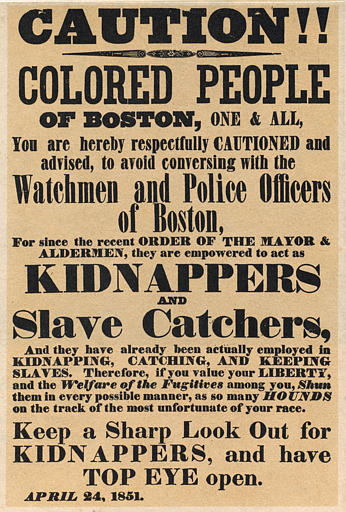BLACK SOCIAL HISTORY
Shadrach Minkins
Shadrach Minkins (1814? - December 13, 1875) was an African-American fugitive slave from Virginia who escaped in 1850 and reached Boston. He is known for being freed from a courtroom in Boston after being captured by United States marshals under the Fugitive Slave Act of 1850. White and black members of the Boston Vigilance Committee freed and hid him, helping him get to Canada via the Underground Railroad. Minkins settled in Montreal where he raised a family. Two men were prosecuted in Boston for helping free him, but they were acquitted by the jury.
Early life
Minkins was born into slavery about 1814 in Norfolk, Virginia.[1]
Escape and capture
He escaped from slavery as a young man in 1850 and reached Boston, Massachusetts, where he became a waiter.[2] Later that year, Congress enacted the Fugitive Slave Law, which allowed federal agents to seize escaped slaves living in free states and return them to their owners. It required law enforcement in all states to cooperate in enforcing this federal law.[3]
United States marshals, who posed as customers at Taft’s Cornhill Coffee House where Minkins worked, arrested him on February 15, 1851.[4][5]
Writ of habeas corpus
Minkins was taken to a hearing at the Boston federal courthouse. Attorneys, including Samuel E. Sewall, Ellis Gray Loring, Robert Morris and Richard Henry Dana, Jr., offered their services to defend Minkins. Seeking to have Minkins released from police custody, they filed a petition for writ of habeas corpus with the Supreme Judicial Court, which was refused by Chief Justice Lemuel Shaw.[5]
Edward G. Walker, Morris and activist Lewis Hayden collaborated to obtain Shadrach's release.[6] White and black members of the anti-slavery Boston Vigilance Committee, including Hayden, entered the courtroom and used force to take Minkins from the marshals.[5][7][8] He was hidden in an attic in Beacon Hill. Minkins escaped Massachusetts with the help of John J. Smith, Lewis Hayden and others. Nine abolitionists were indicted in the affair, but charges were dismissed for some of the individuals. Morris and Hayden were tried and acquitted.[5]
Resulting trials
The rescue of Minkins brought calls for President Millard Fillmore to use federal troops to help marshals enforce the Fugitive Slave Law. Fillmore cautiously called on the citizens of Boston to respect the law and aid in recapturing Minkins. Fillmore ordered Minkins' liberators to be prosecuted.[9] John P. Hale served as defense counsel in the resulting trials.[10] This incident in his home state deeply embarrassed Secretary of State Daniel Webster, who hoped to be elected President in 1852 with Southern support.[11]
Canada
From Boston, activists helped Minkins reach Canada via stops on the Underground Railroad. He settled in Montreal, in the section of the city known as Old Montreal. There he made a living first as a waiter, then operating restaurants of his own and, finally, as a barber.[5][12]
He married in 1853 or 1854.[11]
Minkins died in Montreal in December 1875. He is buried in an unmarked grave near two of his children in Mount Royal Cemetery.[13]

















































































































No comments:
Post a Comment